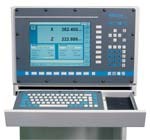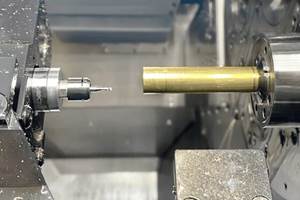Re-Evaluating The Controlled Cycle Lathe
The gap between manual lathes as found in a toolroom and CNC turning centers as found in a production plant is very wide. Many applications call for something in between--a turning machine that not only lends itself to making a single part or a small batch of parts, but also lends itself to complex or difficult operations.
Share




Hwacheon Machinery America, Inc.
Featured Content
View More

Takumi USA
Featured Content
View More



ECi Software Solutions, Inc.
Featured Content
View MoreThe gap between manual lathes as found in a toolroom and CNC turning centers as found in a production plant is very wide. Many applications call for something in between—a turning machine that not only lends itself to making a single part or a small batch of parts, but also lends itself to complex or difficult operations. Lathe manufacturers have responded to this demand by developing a class of turning machines that is rather diverse and goes by a variety of names. These machines have been called semi-CNC, semi-automatic, teachable, hybrid and controlled cycle lathes. The common characteristic of these machines is that they can be operated in a mode involving some level of electronic assistance. Many also can be operated in a strictly manual mode with the operator simply working the handwheels.
The level of electronic assistance found on these machines varies widely. It ranges from a level one step above a simple digital readout that gives the operator prompts, to a level one step below full CNC in which automatic operation does not require standard G-code program input. Given this broad range of electronic modes, it is not surprising that no single term has emerged as an acceptable name for this category of machines.
One of the machine tool builders that is particularly active in this area is Weiler Machine Tools, a German builder with U.S. offices in Fort Mill, South Carolina. This 64-year old firm has a strong reputation in Europe as a builder of high precision toolroom lathes and CNC turning centers. About 10 years ago, the firm began introducing precision lathes with automatic cycles. Although these machines have been widely accepted in Europe, Weiler has found that these machines are not well understood in the U.S. market.
The company ascribes part of this resistance to the general confusion surrounding this category of machines and the unsatisfactory experience some users have had with lower quality imports. Another factor is the scarcity of skilled lathe operators in this country, causing many U.S. companies to conclude that only full CNC machines are the answer to this situation.
Weiler company officials would say that these companies are overlooking a better solution, the lathe with automatic cycles, which the company is now promoting under the term "controlled cycle" lathes. This name seems to be favored because it succinctly characterizes the high level of electronic assistance that it offers while preserving the flexibility that manual operation provides.
The threading routines that can be called up and executed on a Weiler controlled cycle lathe show how one of these machines can perform operations in a way that neither a manual nor a CNC machine could. Recutting a threaded workpiece provides the best example. Responding to prompts on the control interface, the operator selects a thread type, the start and stop points of the thread, and the diameter. The handwheel is used to locate the bottom of the existing thread, and then the operator presses the key to memorize this position. At this point, the operator has an option to start the cycle and let it run with limited handwheel input or choose to maintain complete control over both axes. The lathe will continue to run along the established lead, or the operator may manipulate the axis input using the two handwheels. The display continues to maintain the location, aiding the operator in decisions concerning changes in axis input. According to Weiler, this mode of operation reduces the time of manual rework by about 75 percent compared to unassisted operation, noting that it would be virtually impossible to perform this operation on a CNC machine.
The control features also allow contour routines to be "memorized" easily. The operator generates the contour profile by entering a series of simple profile elements and related dimensions, then lets the system automatically calculate points of intersection, radius blends, tapers and other math functions.
Shop managers who believe that CNC versus manual operation in turning is an either/or situation should take a closer look at the spectrum of machines that fill the gap. These managers may discover a class of turning equipment, such as the Weiler controlled cycle lathes, that transcends both manual and CNC machines. These lathes perform complicated turning operations impossible to do on any manual lathe and, compared to a full CNC machine, they offer considerable time saving through shorter programming and quicker tool setups.
Related Content
3 Tips to Accelerate Production on Swiss Lathes with Micro Tools
Low RPM lathes can cause tool breakage and prevent you from achieving proper SFM, but live tooling can provide an economical solution for these problems that can accelerate production.
Read MoreCustom Motorcycle Parts Made Here: Video Tour of a Family-Owned CNC Machine Shop
Lee Wimmer invited us to tour his second-generation family-owned machine shop in Perkasie, PA. This video explores the production processes behind precision-machined parts for both Wimmer Custom Cycle and LS Wimmer Machine Co., and shows how ingenuity and determination are still at the heart of American manufacturing. Today, both companies are now managed by Wimmer’s three sons.
Read MoreTop Shops: Designing a Shop to Meet Customer Needs
Working closely with customers and making careful investments has enabled this Wisconsin machine shop to tackle difficult jobs with tight deadlines as a core part of its business.
Read MoreA History of Precision: The Invention and Evolution of Swiss-Style Machining
In the late 1800s, a new technology — Swiss-type machines — emerged to serve Switzerland’s growing watchmaking industry. Today, Swiss-machined parts are ubiquitous, and there’s a good reason for that: No other machining technology can produce tiny, complex components more efficiently or at higher quality.
Read MoreRead Next
Setting Up the Building Blocks for a Digital Factory
Woodward Inc. spent over a year developing an API to connect machines to its digital factory. Caron Engineering’s MiConnect has cut most of this process while also granting the shop greater access to machine information.
Read More5 Rules of Thumb for Buying CNC Machine Tools
Use these tips to carefully plan your machine tool purchases and to avoid regretting your decision later.
Read MoreRegistration Now Open for the Precision Machining Technology Show (PMTS) 2025
The precision machining industry’s premier event returns to Cleveland, OH, April 1-3.
Read More



















.png;maxWidth=150)











.jpg;maxWidth=300;quality=90)













